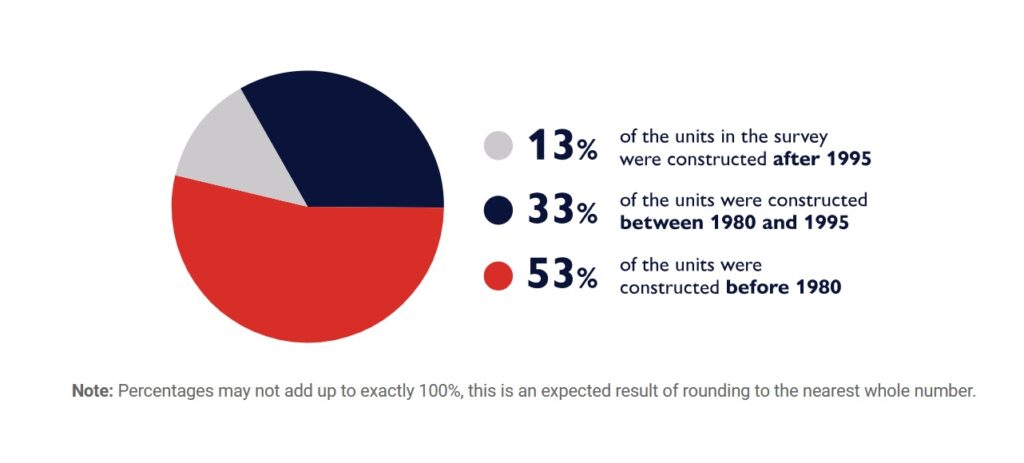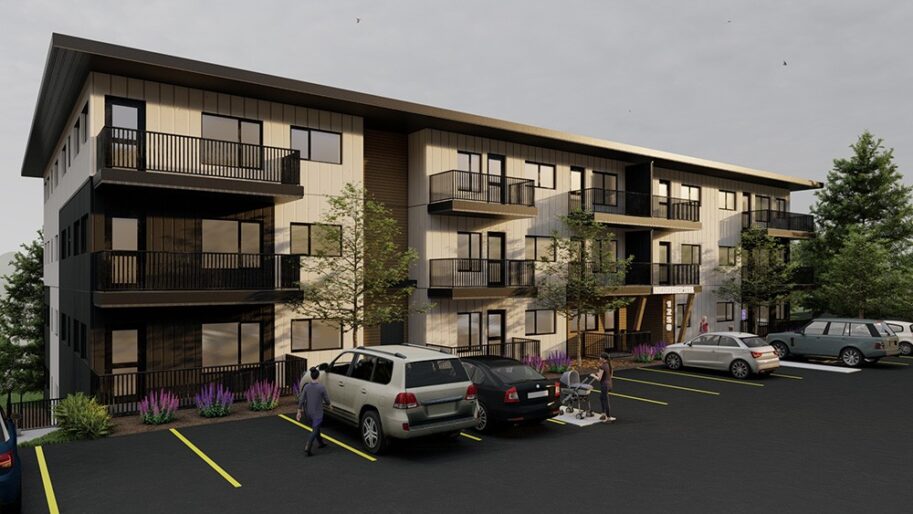With Canada’s national vacancy rate hovering at 2.5 percent in 2022, social and affordable rental housing continues to be in high demand as rental rates climb and homeownership wanes. The two groups most in need of housing assistance, according to the latest survey from CMHC, are families with children at 34 per cent followed by seniors at 23 per cent. Single men and women occupied roughly 10 per cent of total units surveyed, while persons with physical and mental disabilities accounted for just 3 per cent.
On the building stock front, new data suggests that social and affordable housing conditions aren’t dismal, but they aren’t stellar either: 38 per cent of the 565,000 units surveyed by CMHC are deemed to be in “fair/poor” condition; 19 per cent are in “average” condition; and 43 per cent are in “good” or “excellent” condition. Over half the units surveyed were constructed prior to 1980, with the oldest among them naturally making up the bulk of those considered less favourable.
The good news is more housing is on its way, whether it’s purpose-built market rentals or supportive housing for those requiring assistance. Funding through programs like the National Housing Strategy’s National Housing Co-Investment Fund (NHCF), the Rapid Housing Initiative, and BC Housing’s Community Housing Fund are making it possible to bring more of what’s needed to market faster.
Earlier this month, B.C. announced it was moving forward on a three-storey, low rise apartment building (pictured above) in Tofino, offering “rent-geared-to-income” units at 30 per cent of the tenant’s income as well as units reserved for those with very low incomes (i.e. those with disabilities).
“Through investments in affordable housing, our government is providing assistance to those who need it most here in British Columbia and in all corners of the country,” said Taleeb Noormohamed, Member of Parliament for Vancouver Granville. “We are committed to making communities stronger through projects like these. These investments help create new jobs and stimulate the local economy, while providing access to safe, affordable homes for Canadian seniors, families, and individuals.”
Another example of a supportive housing project underway is the “Chez Doris” in Montreal, a 19-room safe living environment for vulnerable women at risk of homelessness. Estimated to cost $10.5 million, future residents here can expect to benefit from quality, new housing and access to community support programs designed to help them thrive as they forge their way toward independence.
“Our government is committed to helping those in need, which is why we are proud to have invested in this initiative in Montréal,” said Soraya Martinez Ferrada, Parliamentary Secretary to the Minister of Housing and Diversity and Inclusion for Hochelaga. “These 19 new units for vulnerable women are providing more than just a safe, stable roof over their heads. For its residents, the building will become a true home, the key to a better life.”

Getting off the ground
Reportedly, there are some 283,800 households in Canada with at least one family member on a waitlist for social and affordable housing. To contend with the backlog, the Affordable Housing Innovation Fund was launched to support new ideas and generate approaches to evolve the affordable housing sector. Projects like 220 Terminal, Vancouver’s first moveable modular housing development, are examples of what can be achieved using forward-thinking housing solutions. Organizations may be eligible for funding if their proposals meet the innovation criteria set out at: Affordable Housing Innovation Fund (cmhc-schl.gc.ca)
Highlights from CMHC’s social and affordable housing survey:
- 65% of those occupying social and affordable housing units were served by government organizations and 21% by non-profit organizations. Individuals exiting homelessness and those with disabilities had a higher likelihood of being served by non-profits than other groups like families, single people or veterans.
- New Brunswick had the highest share of units constructed prior to 1980 while Quebec had the lowest share with the exception of Northwest Territories and Nunavut.
- Nationally, 43% of units across Canada are deemed to be in “excellent” or “good condition” while 38% of units are considered to be in fair or poor condition.
- Building conditions varied widely ranging from only 7% of units rated as excellent or good condition in Manitoba’s social and affordable housing stock, to between 61% and 63% in British Columbia and Quebec, respectively, and up to around 85% of units in both P.E.I and Newfoundland and Labrador.
- In Ontario, Alberta and Manitoba, units in fair or poor condition formed the plurality of units surveyed, ranging from 47% in Ontario, 60% in Alberta, and 91% for Manitoba.
- When age of the stock is accounted for, 75% of units built in Canada after 2003 are rated in excellent or good condition, while only 38% of units built before 2003 are rated similarly.
- Nationally, nearly 19% of buildings in Canada do not expect to make any repairs in the next five years. The most common building features that were expected to be repaired within the next five years were exterior building enclosures (32%) along with heating, ventilation and air conditioning (24%).
- Nationally, 73% of structures have accessibility features.
- Paved walkways for wheelchairs, street level entrance without steps and accessible parking were the most common accessibility features offered.
How were rents determined?
- At 88%, household income was the most common mechanism used to set rents.
- In British Columbia and in Quebec, income was the main rent-setting mechanism for only 58% and 75% of units respectively; however, this percentage is at least 85% in almost all other provinces and territories.
Find out more at: Housing Survey Results for Rental Structures | CMHC (cmhc-schl.gc.ca)






